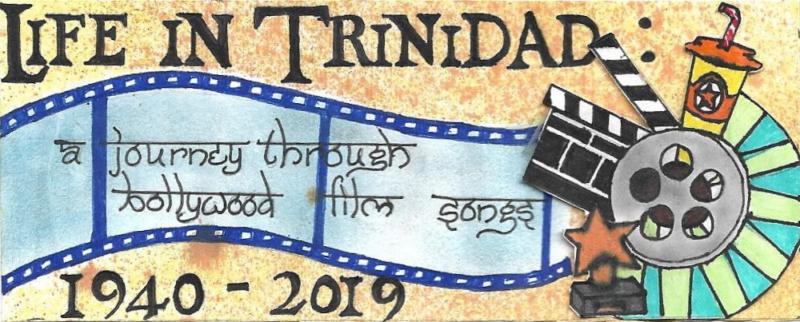India Cricket Tour of the West Indies in 1971
India and the West Indies played their first Test cricket series from November 1948 to February 1949 in India. Five Test matches were played, and West Indies won the series, 1/0. Before the tour of India to the West Indies in 1971, India and the West Indies played four more Test cricket series. West Indies won all of them. In all, West Indies had won 12 out of 23 Test matches, and India had never won a match. This was the background behind the tour of India to the West Indies from February to April 1971. Expectations for the Indian team were not too high. It was generally predicted that history would repeat itself with a whitewash (5-0) like what occurred in the last tour of India to the West Indies in 1962. But, things were about to change and the Test series is now considered a landmark for Indian cricket.
As the Indian team travelled from London to New York, there was an emergency call for the services of a doctor. Sunil Gavaskar, a 21-year old opening batsman from Bombay (now, Mumbai), selected for the first time to tour with the Indian team, had developed an infection on the middle finger of his right hand. He was unable to play in the first two warmup matches against Jamaica and the West Indies Board President’s XI. Consequently, he was not selected to play in the first Test at Sabina Park. The entire first day of the test match was lost due to rain. The match ended in a draw but not before India had forced the West Indies to follow on. There were some splendid performances from the Indian team although they only batted once. Dilip Sardesai scored a double century and Erapalli Prasanna got 4/65 in the West Indies’ first innings. Observers of the game were now starting to take notice of the Indian team.
Second Test at Queen’s Park Oval, Trinidad and Tobago (March 6-10)
The warmup match against Trinidad and Tobago took place at Guaracara Park from March 1-4. The match was drawn but Gavaskar gave the selectors something to think about. He scored 125 in India’s first innings and 63 in the second. He was awarded a trophy by the local firm, AM Querino, for being the best performer on the Indian team. Ashok Mankad who had opened the innings with Gavaskar, also performed well in this match, scoring 79 and 1. This prompted the Indian selectors to select both Gavaskar and Mankad to open the innings in the second Test match. This meant that the second Test would be the Test debut for Gavaskar. It also meant that Jayantilal, one of the openers in the first Test, had to go. The other opener, Abid Ali, was shifted down lower in the batting order.
The second Test got off to an explosive start. After the players of both teams were introduced to the Governor General of Trinidad and Tobago, Sir Solomon Hochoy, West Indies won the toss and decided to bat. Roy Fredericks was out first ball for a duck, lbw to Abid Ali. It was Roy Fredericks’ first Test innings at the Queen’s Park Oval but he did not give the scorers much work to do.
Sir Solomon Hochoy, Governor General of Trinidad and Tobago, Greets West Indies Captain Garry Sobers.
Looking on at Left is Errol Dos Santos and Clive Lloyd at Right. (Trinidad Express, March 7, 1971)
(The old scoreboard at the Queen’s Park Oval is clearly visible in the background.)

Before the end of the first day, the West Indies were bowled out for 214 with Prasanna taking 4/54 and Bishen Singh Bedi capturing 3/46. With seven overs of play remaining, Gavaskar and Mankad walked out to the pitch to open the batting for India. At the close of play, India was 22/0 with Gavaskar not out on 8 and Mankad not out on 14.
At the end of the second day, India was on 247/4. Dilip Sardesai continued his fine form from Jamaica and was on 83 not out at the end of play. Gavaskar made 65 and Mankad made 44, putting up an opening stand of 68. Early in the day when he was just 12, Gavaskar got a chance when he nicked a ball to second-slip off the bowling of Vanburn Holder. Moving to his right, the West Indies captain Garry Sobers dropped the catch. Gavaskar later had a narrow escape when he edged a ball that fell just short of wicketkeeper Mike Findlay.
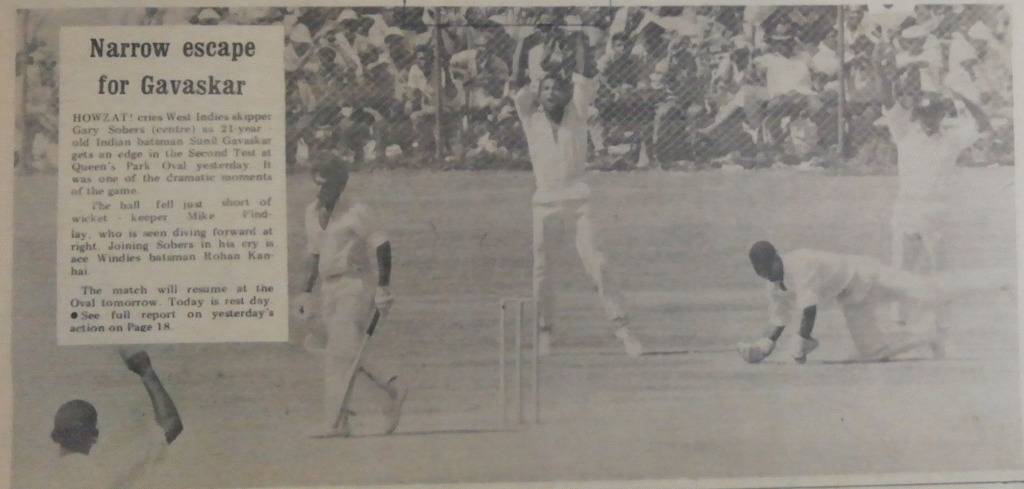
Narrow Escape for Gavaskar in His First Innings of Test Cricket
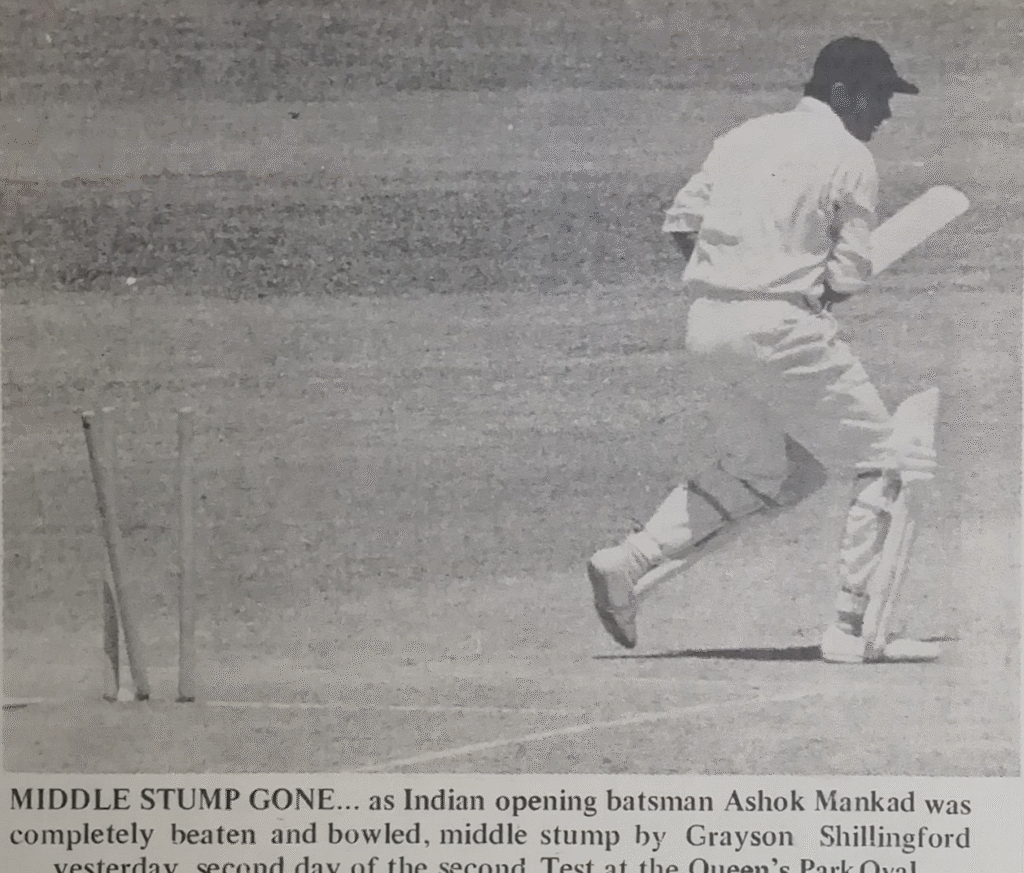
Ashok Mankad is Cleaned Bowled by Grayson Shillingford for 44
(Trinidad Express, March 8, 1971)
Gavaskar Drives Through the Covers During His Knock of 65
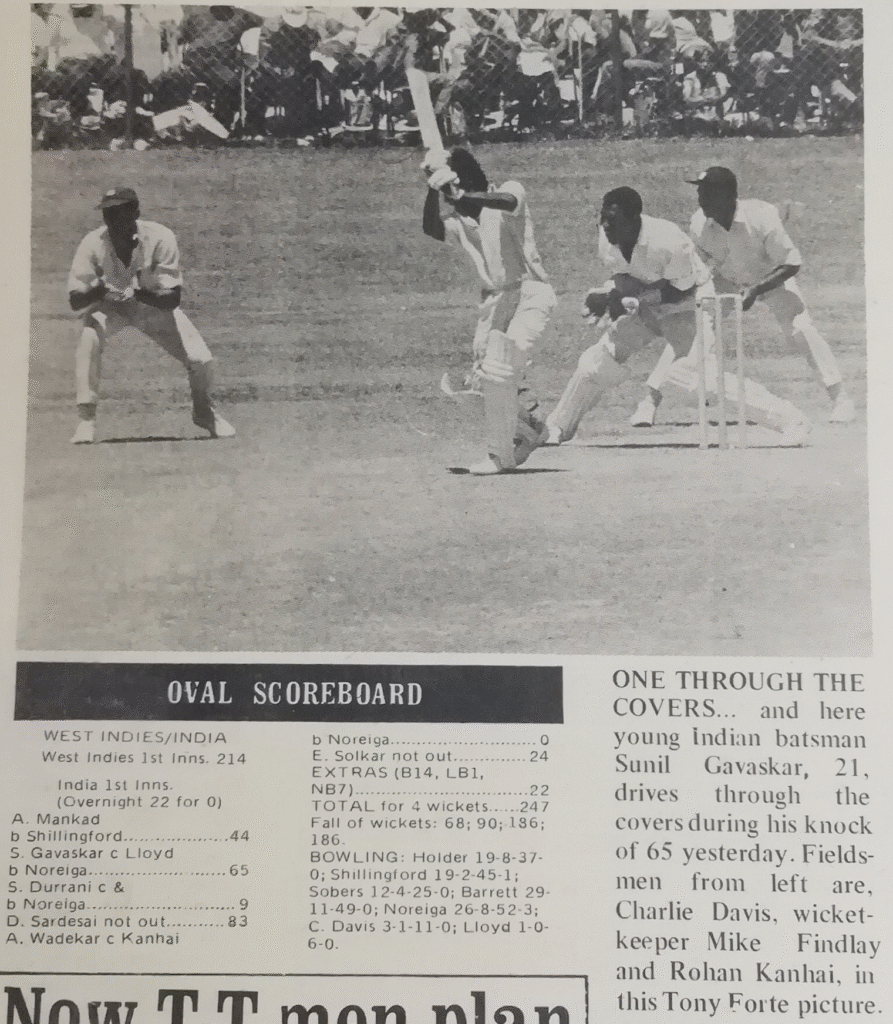
The next day, Monday March 8, was a rest day. When play resumed on Tuesday, no one knew what happened, but India collapsed dramatically for 352, a lead of 138 over the West Indies. Sardesai made another century but did not last long afterwards, getting out for 112. Was it the long break in play that caused the batting slump? Was it the world heavyweight championship fight in boxing (billed as the “Fight of the Century”) between Muhammed Ali and Joe Frazier that took place on the night of the rest day that caused the players to lose focus? Whatever it was, it provided the opportunity for Jack Noreiga, playing in his second Test for the West Indies, to break the record for the most wickets by a West Indian in a Test match when he got 9/95 in India’s first innings. He also became the eighth cricketer in the world to take nine wickets in a Test match.
Jack Noreiga Leads the West Indies Team Off the Field After Bagging 9/95
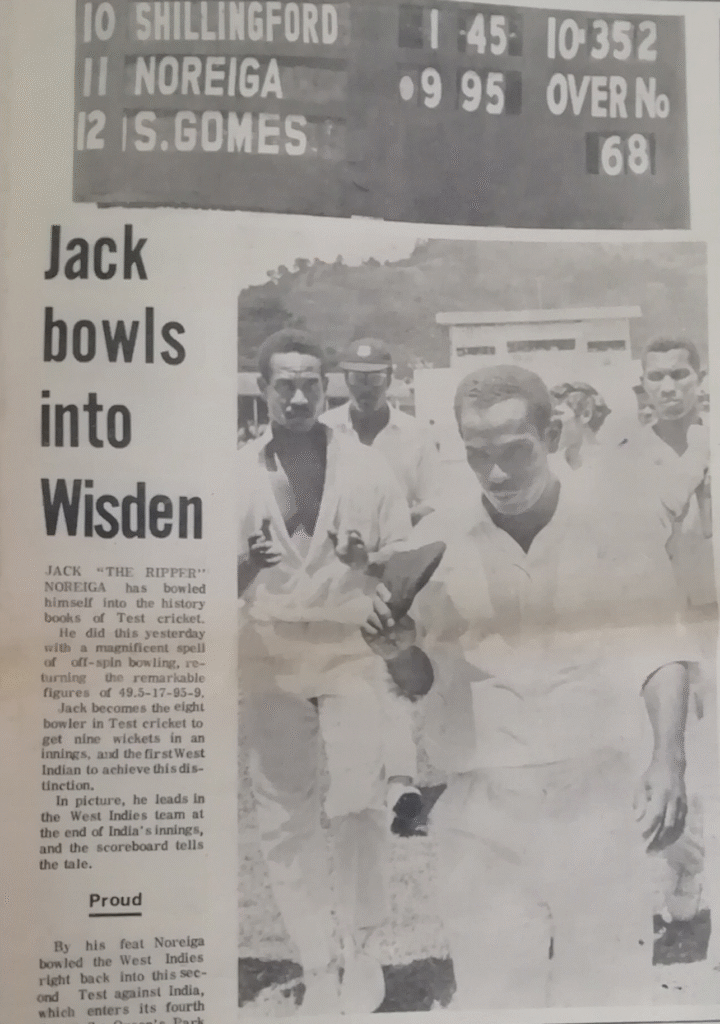
At the end of the third day, the West Indies had erased the 138-run deficit and were 150/1. On the fourth day, the West Indies were bowled out for 261. The bowler doing the most damage for India was Srinivas Venkataraghavan. He got 5/95. Salim Durani made an important contribution by bowling Garry Sobers for a duck and getting Clive Lloyd caught by Wadekar for 15. This meant that India needed a mere 124 runs to win the match.
India got the required runs before the end of the fourth day, with one day to spare. Gavaskar and Mankad had another good opening stand of 74. With the score on 121/3, Gavaskar hit a ball off Arthur Barrett to the boundary, scoring the winning runs for India, and finishing on 67 not out.
Gavaskar is All Smiles as He Walks Back to the Pavilion
It was a memorable victory for India, the first win over the West Indies in 25 Test matches. Occurring in West Indian soil, the victory was even sweeter. It was also a memorable occasion for Gavaskar since the victory took place in his first Test match and his two innings played an important role in securing the victory.
From the start of the warmup match against Trinidad and Tobago on March 1 to the day of victory in the second Test match on March 10, general elections were being held in India. This was the fifth general election since India became independent in 1947. The incumbent Prime Minister, Indira Gandhi, had called elections a year before it was constitutionally due. On March 11, it was announced that Indira Gandhi won the parliamentary majority which she had gambled for by calling early elections, overcoming a split in the Indian National Congress party. The victory by India against the West Indies the day before couldn’t have come at a better time for the newly re-elected Prime Minister.
Gavaskar After Hitting the Boundary to Give India Its First Win Over the West Indies
(Trinidad Express, March 12, 1971)
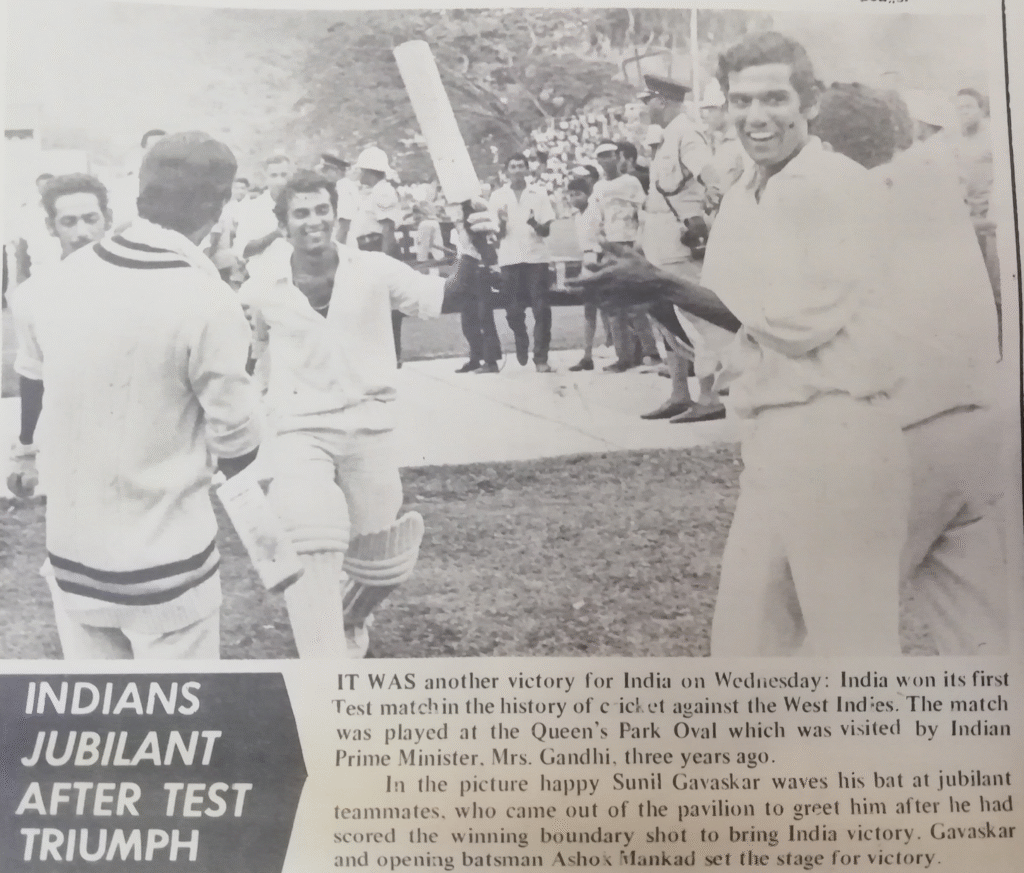
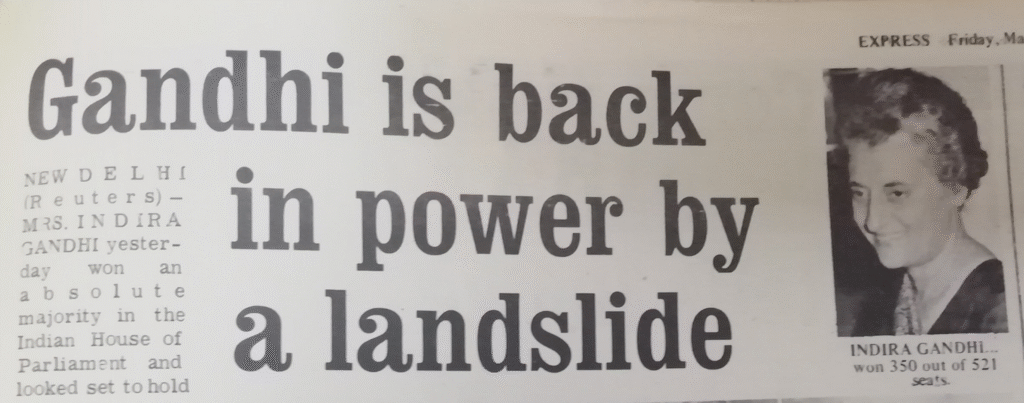
Indira Gandhi is Re-elected as Prime Minister of India
(Trinidad Express, March 12, 1971)
Third Test at Bourda, Guyana (March 19-24) and Fourth Test at Kensington Oval, Barbados (April 1-6)
The West Indies were eager to win a match and level the series with India. However, India did not give them a chance. Both the third and fourth Test matches were drawn. After the fourth Test, India was still leading the series 1/0. Gavaskar continued to play well. In the third Test, he scored another century in India’s first innings (116) and was 64 not out in the second innings. He and Mankad continued their fine opening partnerships. In the first innings of the third test, it was 72 and in the second innings it was an unbeaten 123. In the fourth test, Gavaskar got out cheaply for 1 in the first innings but was 117 not out when the match ended on the fifth day. In this match, the opening partnerships with Mankad were not very productive. However, Sardesai scored another big century in the fourth Test match (150).
Fifth Test at Queen’s Park Oval, Trinidad and Tobago (April 13-19)
The West Indies and India returned to the Queen’s Park Oval in Trinidad for the fifth and final test. What a showdown it was! As was the custom in those days, the last test match in a five-match series was six days long, with an additional rest day. So, the match was scheduled for one entire week and was played from April 13-19. The West Indies had to win this match to level the series. Otherwise, it would be the first Test series win for India over the West Indies.
India won the toss and decided to bat. By the end of first day’s play, they were on 247/5. Gavaskar had struck another century and was on 102 not out. Sardesai batted well for 75. On the second day, India was bowled out for 360, with Gavaskar making 124.
The End of Gavaskar – For Now
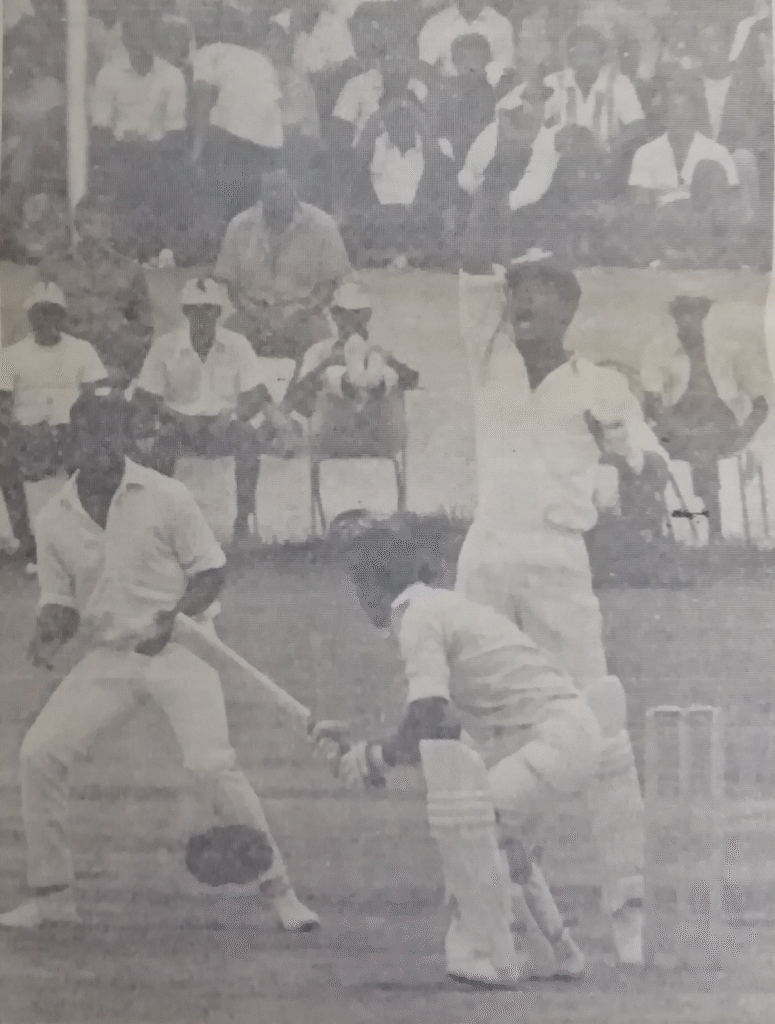
Gavaskar As He is Caught by Wicketkeeper Desmond Lewis Off the Bowling of David Holford for 124
(Trinidad Express, April 15, 1971)
In reply, the West Indies put on a strong batting performance. At the close of play, the West Indies were 117/2. The next day, West Indies batted the entire day and closed on 377/5. Batting for the West Indies, Charlie Davis made 105 and Garry Sobers made 114 not out, his first test hundred at the Queen’s Park Oval.
April 16 was the rest day. When play resumed on April 17, West Indies went on to make 526, a lead of 166, which was not enough to enforce the follow on. Maurice Foster narrowly missed a century; he was bowled by Abid Ali on 99. At the close of play, with two days to go, India was 94/1 with Gavaskar on 57 not out. The odds seemed to favour a victory by the West Indies. Writing for the Trinidad Express newspaper on April 18, sports-writer George Baptiste had this to say:
"But bar a thunderstorm, you can mark down this test to a West Indies victory and a tied series."
George Baptiste(Newsday Sports Editor)
There was no thunderstorm, but Gavaskar had other plans. He batted for the entire fifth day and was 180 not out at the end of the day. India closed the day on 324/4. On the last day of the match, India went on to make 427. Gavaskar made 220 and wrote himself into the record books. He became the second player in the world to score a century and a double century in the same match (after Doug Walters of Australia who did so against the West Indies in 1969).
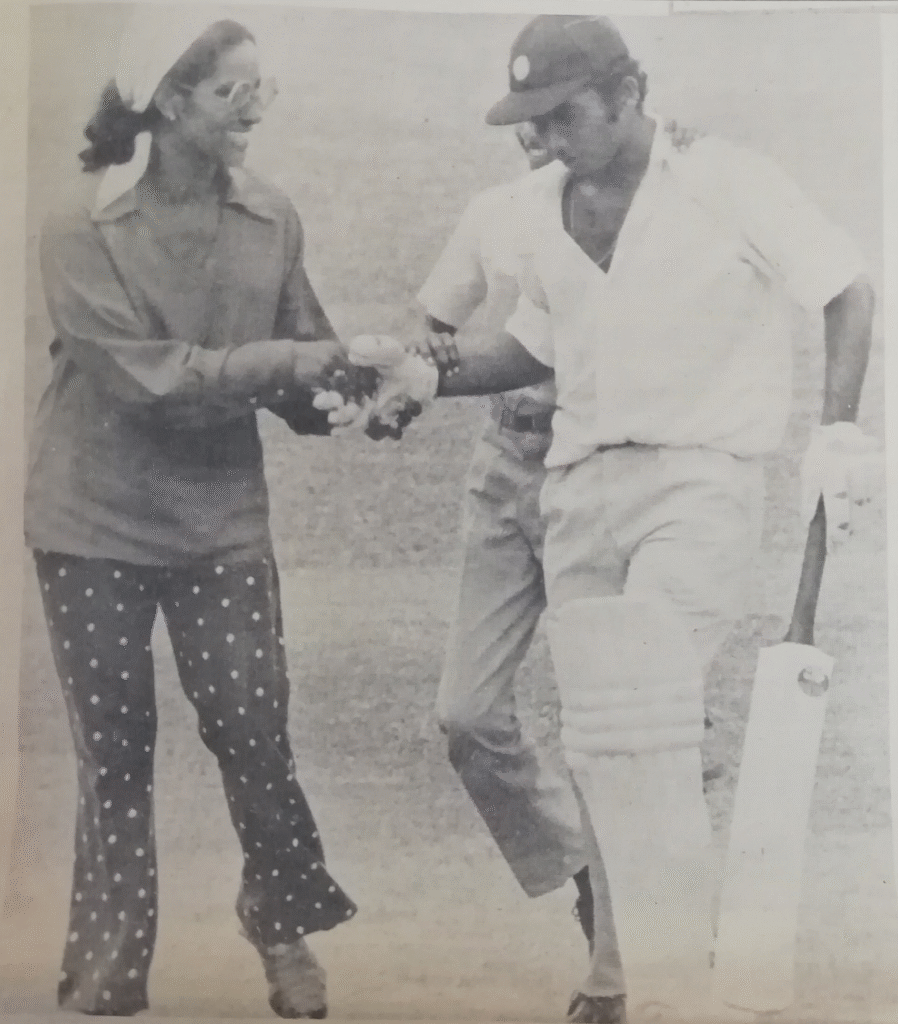
A Young Lady Congratulates Gavaskar on His Way Back to the Pavilion after Scoring 220
(Trinidad Express, April 20, 1971)
To win the match, West Indies had to make 262 in less than two sessions. West Indies took up the challenge. However, they had a disastrous start, losing two early wickets for just 16 runs. At 50, they lost two more wickets when Abid Ali bowled Rohan Kanhai for 21 and Garry Sobers for a duck.
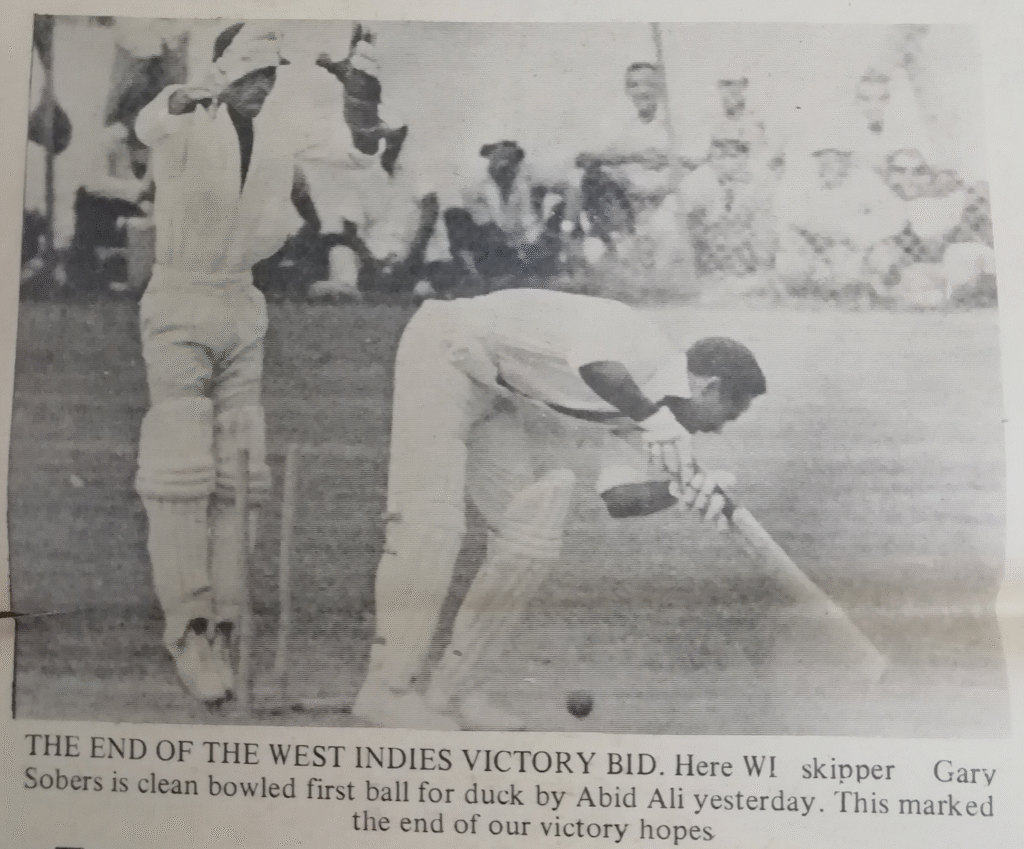
Garry Sobers is Cleaned Bowled by Abid Ali for a Duck (Trinidad Express, April 20, 1971)
By the tea break, the West Indies were tottering on 74/4 and had lost all hopes of winning the match. In fact, it was quite possible that India could now win the match. In the final session, with their backs against the wall, the West Indies lost 8 wickets with two overs of the mandatory 20 still to go. Desmond Lewis and Uton Dowe held on tightly to their wickets for the last two overs to deny India their second victory. At the close of play, West Indies were 165/8. The match was drawn, giving India their first series win over the West Indies.
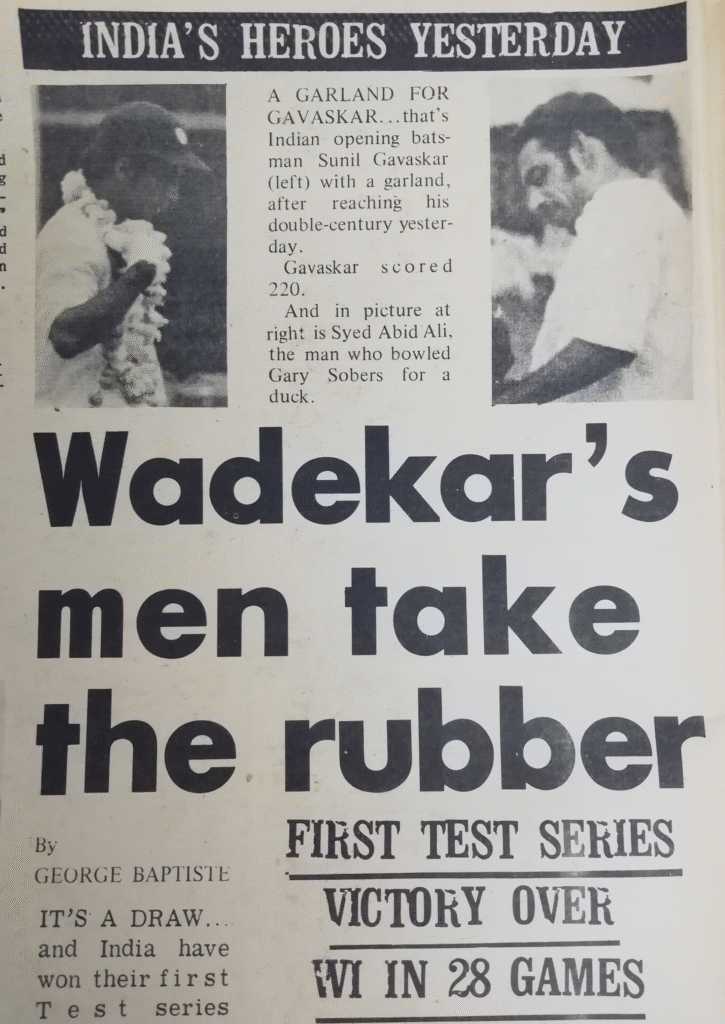
India Wins the Test Series Against the West Indies (Trinidad Express, April 20, 1971)
After the series victory for India, an editorial in the Trinidad Express Newspapers on April 21, 1971 had this to say:
“The better team won. There can be little doubt about it. The visiting Indians outplayed the West Indies by the sheer consistency of their performance. Their bowling was always tight and frequently penetrative; the tenacity of their batting was exemplary; they held their catches and the morale of their team was higher. In addition, there was youth and Gavaskar on their side.”
Despite excellent performances from other members of the Indian team (e.g., Dilip Sardesai scored two centuries and a double century with an aggregate of 642 runs in the series), Sunil Gavaskar became the new cricket sensation. Mr. Ram Prakash Mehra, Vice-President of the Indian Cricket Board of Control hailed Gavaskar as the “Little Master”. He had scored 774 runs in the series on his Test debut (three centuries and a double century) and became the first Indian batsman to score over 700 runs in a test series. His Test series aggregate record still stands.
The prolific and resilient batting of Gavaskar inspired Lord Relator (Willard Harris), a calypso singer from Trinidad, to write a delightful calypso in his honour for the 1972 Carnival season. Like many of the Bollywood film songs featured at this website, the calypso is a timeless classic. Its catchy refrain became very popular in Trinidad and Tobago in the early 1970s:
“It was Gavaskar,
De real master
Just like a wall,
We couldn’t out Gavaskar at all, not at all
You know the West Indies couldn’t out Gavaskar at all”
In the calypso, Lord Relator balances his praise for the Indian team with fearless criticism of the West Indies players (“But Sobers as a captain, he want plenty coachin’”). What is admirable about the song is that it captures the prevailing West Indian sentiments of disappointment and “shame” of having lost the series in its own backyard as well as the frustration of the local fans with the West Indies players; at the same time, it recognizes that something special had happened and does not hold back on its praise for the Indian players, especially Gavaskar. Because of its simplicity and beauty, and its message that one could heap praise on an opponent even after being outplayed, this is probably one of the greatest calypsos on cricket ever made.
The Indian team returned to Bombay on April 23, 1971. Large crowds came to meet the team when they arrived at the airport. It was a moving experience to witness the many people who wanted to see the players who had brought back victory for India. The team was met by newly re-elected Prime Minister Indira Gandhi not too long afterwards. Fittingly, Sunil Gavaskar became the Sportsman of the Year for 1970-1971. The video below shows some scenes before the Indian team left for the West Indies, some scenes from the matches in the West Indies (most are not very clear), and the return of the team to India.
Bishen Singh Bedi and Garry Sobers Become Fathers
On the morning of Sunday April 18, the fifth day of the final test match, Bishen Singh Bedi received news that his wife had delivered a baby boy at the Moolchand Hospital in New Delhi the previous night. Bedi was so impressed with Gavaskar’s batting performance on the tour that he later named his son, “Gavas Inder Singh”, much to Gavaskar’s delight. (In hindsight, “Gavas” was probably not a good choice since a rift later developed between the two men.)
On the evening of that same Sunday, the West Indies captain Garry Sobers also received word that his wife had given birth to a son at a Nottingham hospital in England. Lord Relator cheekily suggests in his calypso that this was the reason why Sobers got bowled for a duck by Abid Ali the next day. It was the first child for both Bedi and Sobers.
At the end of the fifth test match, when asked about future prospects for their newborn sons, Sobers reportedly told Bedi, “My boy will give your boy a lot of hell.” Fresh from the series defeat, Sobers was probably reflecting on the hell the West Indies had just received from the visiting Indian team.
